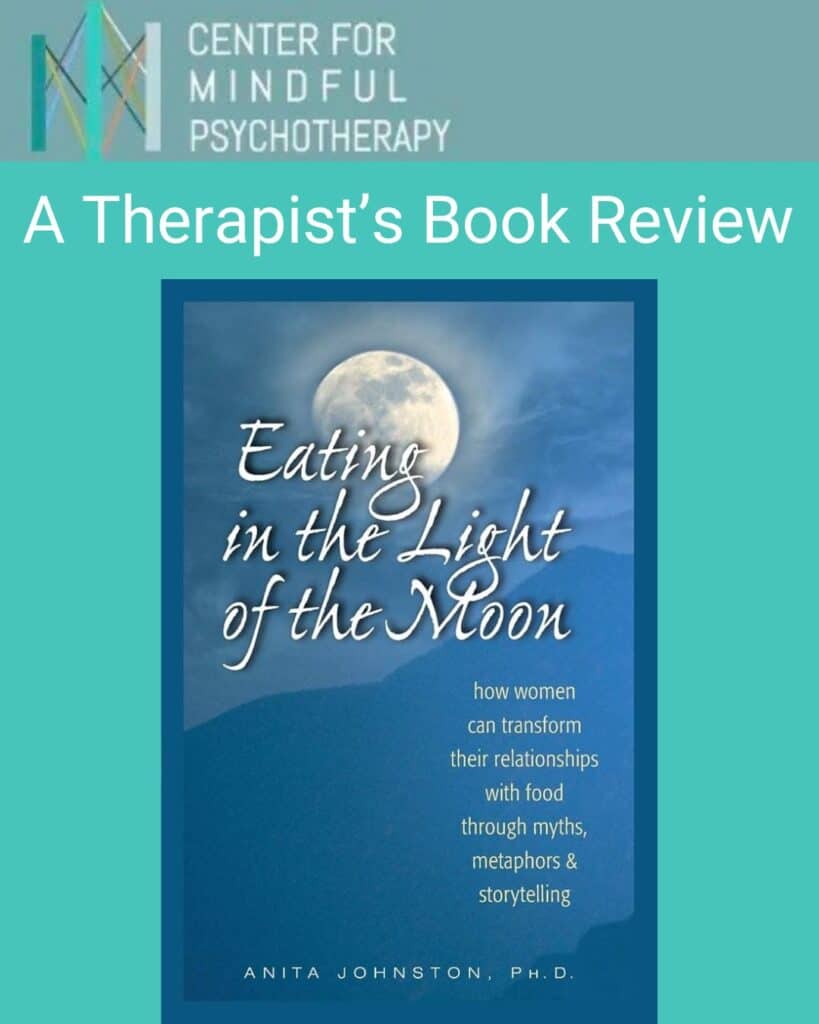
This is a book review by Phoenix L. Quetzal DeLeon, MA, AMFT, a somatic therapist at the Center for Mindful Psychotherapy who specializes in supporting individuals working through eating disorders, body image concerns, anxiety, and trauma recovery. In this review, Phoenix reflects on Eating in the Light of the Moon: How Women Can Transform Their Relationship with Food Through Myths, Metaphors & Storytelling by Anita Johnston, PhD, a book that, as Phoenix shares, changed their life when they first encountered it over 20 years ago. Revisiting it now through the lens of both personal recovery and professional practice, Phoenix offers insights into why this work remains relevant, what makes it transformative, and how it might serve as a valuable resource for those navigating their own journeys with disordered eating.

Book Review: Eating in the Light of the Moon
by Anita Johnston, PhD
Review by Phoenix L. Quetzal DeLeón AMFT
This book changed my life. The first time I read it was over 20 years ago, and it still feels relevant to therapy practice today. A gentle trigger warning – this book review discusses disordered eating and Johnston’s exploration of understanding and treating eating disorders.
As someone who has recovered from an eating disorder, I hold a lot of personal awareness and experience in working through many of the issues discussed in Eating in the Light of the Moon. However, at the time when I first read this book, it didn’t occur to me that part of what I was struggling with was an eating disorder. Back then, as I read through the initial chapters of the book, it was a bittersweet revelation that Johnston was describing so many ways in which I had struggled to be seen, heard, and understood throughout my life – and also the ways in which I was trying to cope. It led me to seek the therapy that I needed, which ended up transforming my understanding of myself, my relationships and the world around me. Now, as I review this book through the lens of recovery, after many years of working with an eating disorder specialist, I recognize the insights that Johnston shares as something more: a profoundly meaningful gift to the world that has made a huge difference in many people’s lives.
With that grand pronouncement as a prologue, I’ll begin my review by saying that this book is definitely framed by and oriented towards women’s experiences – there is a clear feminist perspective that shines brightly in Johnston’s writing. Discussion around “reclaiming the feminine in a masculine world” and the ways in which disordered eating might show up as an attempt to thwart a sense of powerlessness, open the book. Johnston makes a point of using she/her pronouns throughout, and centers the experiences of women, something that in the late 1990’s – when this book was being written -was still a fairly rare reading experience in non-fiction.
Eating in the Light of the Moon is structured as a sort of “how to” self-help book; the subtitle reads: “how women can transform their relationships with food through myths, metaphors & storytelling.” It’s not your typical “how to” manual, however; this book is more of an intuitive guide into the imaginal realm of the psyche, explored through metaphor, stories and myths from many different cultures. That said, this is also a book based in research, and Johnston uses the themes that emerged from her research with a great deal of thoughtfulness and creativity in organizing the book. She explores a wide variety of subjects, including addiction, symbolism, power, sexuality, nurturance and dreams. The chapter titles say a lot about the content, and have a bit of a magnetic pull – each time I read “Feelings: Gifts from the Heart” or “Moontime: Reclaiming the Body’s Wisdom” or “Relationships: Singing the Truth,” I feel drawn to dive into that chapter.
There is also a unifying symbol that recurs throughout the book, and is ever-present as an image at the end of each chapter: the labyrinth. Johnston starts by framing the journey of working with eating disorders as a labyrinth, and explains that the road to recovery is not a straight line. This image shows up time and again, as the author delves into the why and how eating disorders can develop over time. The labyrinth image also plays a key role in the unwinding of layers of trauma, erasure, neglect, invisibility, relational distress and male-dominated power dynamics that are often intertwined with attachment to controlling, or allowing to be out of control, one’s relationship with food and eating. “Recovery: Out of the Labyrinth” is the title of the second to last chapter, and this is where Johston brings together all of the themes in the book as a means of solving, or stepping out of, the labyrinth into recovery. Is this book perfect? No – I think there are ways in which it might feel a little overbearing or miss the mark for some folks, especially if the reader does not resonate with the author’s intuitive writing style and perspective taking around eating disorders. It was also first published more than 20 years ago, and there are some frameworks in the book that could be updated to reflect more modern awareness and sensibility around feminism and inclusivity. That said, I believe that this book could be a good starting place for grounding oneself in the basics of understanding what eating disorders are, how they might arise, and how they can potentially be treated. While I do not recommend that anyone struggling with an eating disorder attempt to work through it without therapy and other relevant support, I believe that this book can be of value to anyone who might be struggling with disordered eating, or who wants to understand this experience at a deeper level.
Phoenix L. Quetzal DeLeón AMFT #129332
Voicemail: (408) 706-2770
Website: https://www.therapywithphoenix.com/
Email: [email protected]
More from therapist Phoenix L. Quetzal DeLeon:

